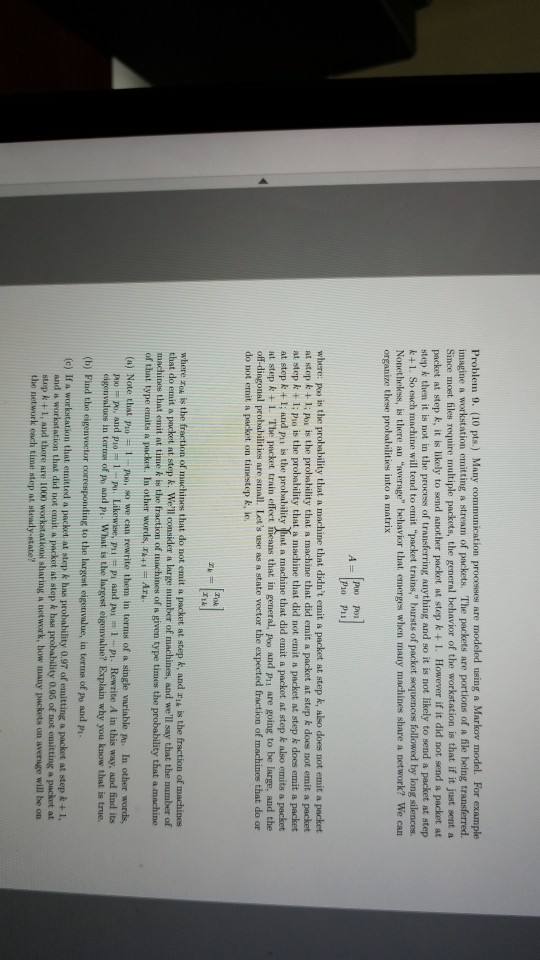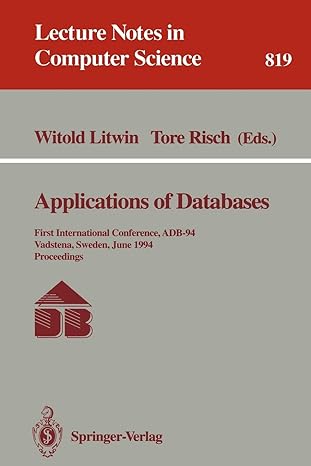Answered step by step
Verified Expert Solution
Question
1 Approved Answer
Problem 9. (10 pts.) Many communication proccsses are modeled using a Markov model. For example imagine a workstation emitting a stream of packets. The packets

Problem 9. (10 pts.) Many communication proccsses are modeled using a Markov model. For example imagine a workstation emitting a stream of packets. The packets are portions of a file being transferred. Since most files require multiple packets, the general behavior of the workstation is that if it just sent a packet at step k, it is likely to send another packet at step k +1. However if it did not send a packet at step k then it is not in the process of transferring anything and so it is not likely to send a packet at step k+1. So each machine will tend to emit "packet trains," bursts of packet sequences followed by long silences. Nonetheless, is there an "average" behavior that emerges when many machines share a network? We can organize these probabilities into a matrix where: poo is the probability that a machine that didn't emit a packet at step k, also does not emit a packet at step k + 1; pos is the probability that a machine that did emit a packet at step k does not emit a packet at step k + 1; Pso is the probability that a machine that did not emit a packet at step k does emit a packet at step k +I; and pi is the probability (hat a machine that did emit a packet at step k also emits a packet at step k +1. The packet train efect feans that in general, poo and pu are going to be large, and the off-diagonal probabilities are small. Let's use as a state vector the expected fraction of machines that do or do not emit a packet on timestep k, ic. where ro is the fraction of machines that do not emit a packet at step k, and rit is the fraction of machines that do emit a packet at step k. We'lI consider a large number of machines, and we'll say that the number of machines that emit at time k is the fraction of machines of a given type times the probability that a machine of that type emits a packet. In other words, AtH Ar (a) Note that P1-?-Pos so we can rewrite them in terms of single variable po. In other words, Pxo # o. And pio 1po. Likewse, PIP and po m 1-Pi. Rewrite A in this way, and find its eigenvaluos in terms of po and Pi. What is the largest eigenvalue? Explain why you know that is true. (b) Find the eigeuvector corresponding to the largest cigouvalue, in terms of po and p. (c) If a workstation that emitted a packet at step k has probubility 0.97 of emitting a packet at step k + 1, step k +1, and there are 1000 workstations sharing a network, how many packets on average will be on and s workstation that did ne t emit a packet at step k has probability 0.95 of not emittinga Problem 9. (10 pts.) Many communication proccsses are modeled using a Markov model. For example imagine a workstation emitting a stream of packets. The packets are portions of a file being transferred. Since most files require multiple packets, the general behavior of the workstation is that if it just sent a packet at step k, it is likely to send another packet at step k +1. However if it did not send a packet at step k then it is not in the process of transferring anything and so it is not likely to send a packet at step k+1. So each machine will tend to emit "packet trains," bursts of packet sequences followed by long silences. Nonetheless, is there an "average" behavior that emerges when many machines share a network? We can organize these probabilities into a matrix where: poo is the probability that a machine that didn't emit a packet at step k, also does not emit a packet at step k + 1; pos is the probability that a machine that did emit a packet at step k does not emit a packet at step k + 1; Pso is the probability that a machine that did not emit a packet at step k does emit a packet at step k +I; and pi is the probability (hat a machine that did emit a packet at step k also emits a packet at step k +1. The packet train efect feans that in general, poo and pu are going to be large, and the off-diagonal probabilities are small. Let's use as a state vector the expected fraction of machines that do or do not emit a packet on timestep k, ic. where ro is the fraction of machines that do not emit a packet at step k, and rit is the fraction of machines that do emit a packet at step k. We'lI consider a large number of machines, and we'll say that the number of machines that emit at time k is the fraction of machines of a given type times the probability that a machine of that type emits a packet. In other words, AtH Ar (a) Note that P1-?-Pos so we can rewrite them in terms of single variable po. In other words, Pxo # o. And pio 1po. Likewse, PIP and po m 1-Pi. Rewrite A in this way, and find its eigenvaluos in terms of po and Pi. What is the largest eigenvalue? Explain why you know that is true. (b) Find the eigeuvector corresponding to the largest cigouvalue, in terms of po and p. (c) If a workstation that emitted a packet at step k has probubility 0.97 of emitting a packet at step k + 1, step k +1, and there are 1000 workstations sharing a network, how many packets on average will be on and s workstation that did ne t emit a packet at step k has probability 0.95 of not emittinga
Step by Step Solution
There are 3 Steps involved in it
Step: 1

Get Instant Access to Expert-Tailored Solutions
See step-by-step solutions with expert insights and AI powered tools for academic success
Step: 2

Step: 3

Ace Your Homework with AI
Get the answers you need in no time with our AI-driven, step-by-step assistance
Get Started


